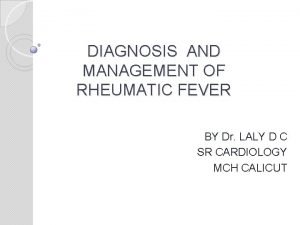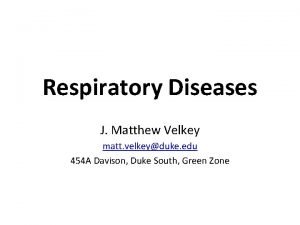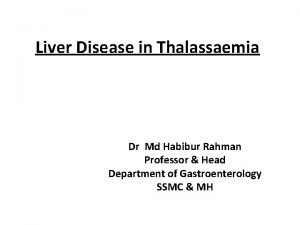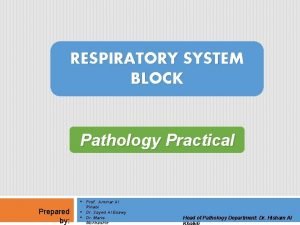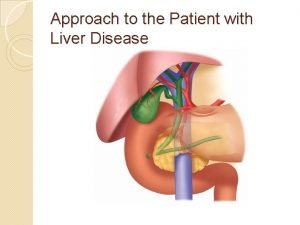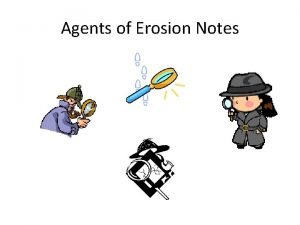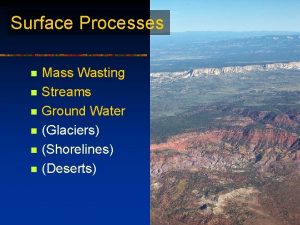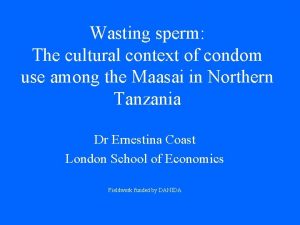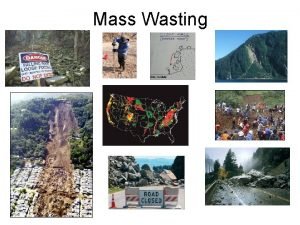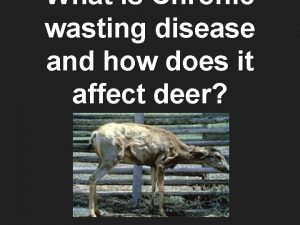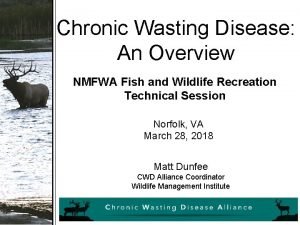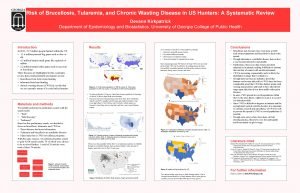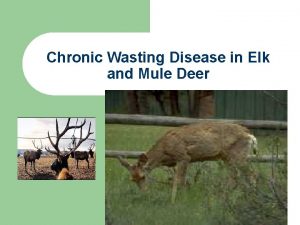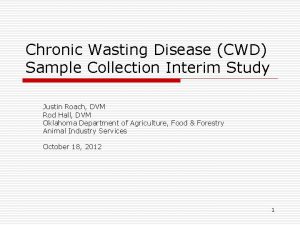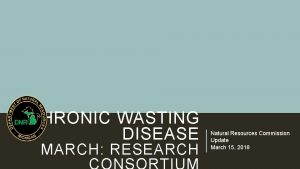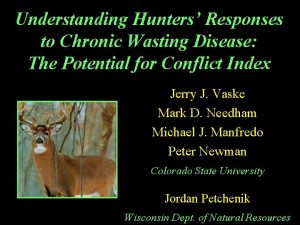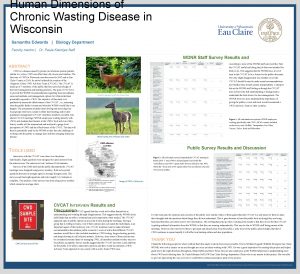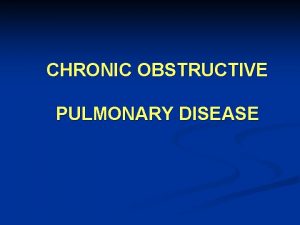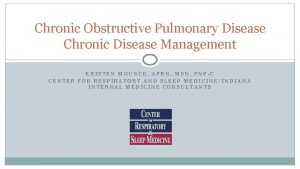Chronic Wasting Disease in Montana The disease surveillance




































- Slides: 36

Chronic Wasting Disease in Montana The disease, surveillance, and planning for future management.

What is Chronic Wasting Disease (CWD)? • Slow moving, always fatal neurological disease of deer, elk and moose. • Caused by an infectious misfolded prion protein (not a virus or bacteria). • Named for symptoms that appear in terminal stages of infection. - Emaciation and excessive salivation. - Lack of muscle coordination and carrying head and ears lowered. • Infectious at 5 -7 months; symptomatic at 14 -15 months; death within 2 years.

Transmission • Most commonly transmitted by animal-toanimal contact. • Contact with a prion-contaminated environment (e. g. grass and soil). • Infected animals shed prions in saliva, feces, and urine, and via bodily tissues and fluids upon death. • Prions remain infectious for at least 2 years. • Not known to be transmissible to humans.

Potential Impacts • Infected animals die at a faster rate. • Population declines of deer in heavily infected herds. • Increased spread of the disease. • A decrease in Montana’s wildlife recreation opportunities. In Colorado, populations of mule deer dropped 45% over a twenty-year period. In Wyoming, biologists observed a 21% annual decline in one infected herd.

Where is CWD? • First known case Colorado 1967. • Now in captive or free-ranging herds in 26 states, 3 Canadian provinces, Norway, Finland, and South Korea. • First detected in wild deer in Montana in 2017. • Detected in farmed elk in Philipsburg in 1999.

Prevention • No vaccines for CWD. Prevention is critical to manage spread of CWD across Montana. • Prohibition of the transport of live cervids/carcasses of cervids from CWD -positive states. • Voter initiative ban on game farms in 2000 (Ballot Initiative 143). • Historic management emphasizing opportunity. • Laws banning the feeding of wildlife. • Regulation of the use and import of cervid urine lures from CWD positive states.

2019 CWD Surveillance and Monitoring • Goal: Detect CWD if present at ≥ 1% with 95% confidence. • High-priority surveillance units visited on 3 -year rotation. • Sample hunter harvested, symptomatic and road-killed deer and elk. • Test retropharyngeal lymph nodes and obex at CSU.

Sampling & Testing • Sample collection at check stations & regional offices. • Removing retropharyngeal lymph nodes or brain stem, tooth, and genetic sample. • Samples sent to CSU. • Test results will be posted online within 3 weeks.

Sampling Outside Priority Surveillance Area • Hunters can submit their own samples to CSU. • Directions on FWP CWD homepage. • CSU charges $18 for ELISA test plus shipping.

FWP’s CWD Response Plan • Main objective is to manage CWD, not to eradicate it. • Montana prioritizes recreational opportunities in its plan.

CWD Management

2017 Surveillance & Special Hunts: 11 CWD Detections • Sampled 2003 hunter harvested, symptomatic and road-killed deer, elk, and moose. <1% prevalence among MD R 4: 1 MD (♂) R 5: 8 MD (5♂, 3♀) 2 WTD (♀) 2% prevalence among MD 1% prevalence among WTD

2018 Surveillance: 26 CWD Detections • Sampled 1, 922 hunter harvested, symptomatic and road-killed deer, elk, and moose. R 4: 1 WTD (♂) R 5: 4 MD (2♂, 2♀) 1 WTD (♂) R 6: 19 MD (18♂, 1♀) 1 WTD (♂) <1% prevalence among MD <1% prevalence among WTD 3% prevalence among MD <1% prevalence among WTD 2% prevalence among MD 2% prevalence among WTD

CWD Management Update • Working to define long term CWD Management Zones which will include transport restrictions. • Working with regions to develop CWD management strategies / plans and long term monitoring. • Future surveillance will focus on periphery of known positive areas.

2019 CWD Management Zones

Transport Restrictions in all CWD Zones Animal parts that CAN be removed from the CWD Management Zone or brought into Montana from other states include: • Meat cut and wrapped or boned out. • Quarters with no spinal column or head attached. • Hides with no heads attached. • Skull plates or antlers with no meat or tissue attached. • Skulls that have been boiled and cleaned to remove flesh and tissue. • Upper canine teeth and head, partial body, or wholebody mounts prepared by a taxidermist.

Human Health Precautions No evidence CWD is transmissible to humans. • Do not eat meat from animals that look sick or test positive for CWD. • CDC recommends hunters who harvest a deer, elk, or moose from a known CWD-infected area have the animal tested prior to consuming it. • Recommend quartering / freezing until test results returned. • If hunters harvest an animal that looks sick, contact FWP and have the animal inspected. www. cdc. gov/prions/cwd/transmission

Human Health Precautions To decrease potential risk of exposure to CWD, hunters should: • Wear rubber gloves and eye protection when field dressing deer, elk or moose. • Minimize the handling of brain and spinal tissues. • Wash hands and instruments thoroughly after field dressing. (concentrated household bleach or hypochlorous acid (HOCl, Briotech Inc. ) • Avoid eating brain, spinal cord, eyes, spleen, tonsils and lymph nodes of harvested animals. www. cdc. gov/prions/cwd/prevention

How you can help Please help us prevent spread of CWD within Montana. • Submit samples from harvested animals to CSU and share results with FWP. • Have your animal tested if harvested in a CWD Management Zone. • Be aware: all CWD positive deer appeared normal and healthy in 2018. • Report sick looking animals to FWP staff for testing. • Minimize handling of brain and spinal tissue. • Take precautions when field dressing. Properly dispose carcasses, hides, or trimmings in a landfill. • ‘Pass it on’ – mentor other hunters.

For more information fwp. mt. gov/cwd

Questions?


Dr. Frank Bastian • No other TSE researchers have confirmed his findings. • The TSE field all believe TSE diseases are caused by prions. • Key evidence refuting Dr. Bastian (from Dr. Brent Race NIH) - Prions can be exposed to extreme temperatures and chemical treatments that would inactivate or destroy all bacteria. Prions remain infectious following these treatments. - Can reproducibly cause prion disease in the absence of any spiroplasma bacteria. - Bastian is studying a bacterial disease that causes some brain lesions but it IS NOT a true TSE like CWD.

2017





FWP CWD Planning • CWD surveillance began in 1996. • Previous CWD plans and decision notices (2005 & 2013). • Risk modelling to inform priority surveillance areas (2014). • Internal CWD Action Team (2016). • CWD Citizen’s Advisory Panel (2017). • Renewed surveillance efforts (2017). • Updated surveillance and management plans (2017 -2018).

Weighted Surveillance • Focus on mule deer and high risk demographic groups. • 300 “point” system. • Symptomatic, road kill, and adult bucks are most valuable. • Points vary by species

CWD Surveillance • Goal: Detect CWD if present at ≥ 1% with 95% confidence. • High-priority surveillance units visited on 3 -year rotation. • Sample hunter harvested, symptomatic and road-killed deer and elk. • Test retropharyngeal lymph nodes and obex at CSU.

Potential Management Actions

2017 Surveillance & Special Hunts: 11 CWD Detections • Sampled 2003 hunter harvested, symptomatic and road-killed deer, elk, and moose. R 4: 1 MD (♂) R 5: 8 MD (5♂, 3♀) 2 WTD (♀)

2018 Surveillance: 26 CWD Detections • Sampled 1, 922 hunter harvested, symptomatic and road-killed deer, elk, and moose. R 4: 1 WTD (♂) R 5: 4 MD (2♂, 2♀) 1 WTD (♂) R 6: 19 MD (18♂, 1♀) 1 WTD (♂)

Funding • Deer & Elk auction dollars • Pittman-Robertson federal grant • Rocky Mountain Elk Foundation • Mule Deer Foundation

Thank you • FWP staff • Hunters • Landowners • Residents and communities • Vigilant wildlife watchers • State, Federal and Tribal agency partners
 Chronic disease
Chronic disease Ersd
Ersd Chronic rheumatic heart disease
Chronic rheumatic heart disease Nonalcoholic fatty liver disease
Nonalcoholic fatty liver disease Chronic granulomatous disease
Chronic granulomatous disease Nursing management of cirrhosis of liver
Nursing management of cirrhosis of liver Dcld vs cld
Dcld vs cld Kate lorig stanford
Kate lorig stanford Stigmata of chronic liver disease
Stigmata of chronic liver disease Chronic disease
Chronic disease Chronic kidney disease near oakley
Chronic kidney disease near oakley Developedbyed
Developedbyed Jewish chronic disease study
Jewish chronic disease study Copd disease
Copd disease Stigmata of chronic liver disease
Stigmata of chronic liver disease Mass wasting
Mass wasting Santa tecia
Santa tecia Mass wasting processes
Mass wasting processes Subsidence mass wasting
Subsidence mass wasting Central diabetes insipidus labs
Central diabetes insipidus labs The respiratory system just wasting away answer key
The respiratory system just wasting away answer key Landslides caused by earthquakes
Landslides caused by earthquakes Mass wasting occurs when____.
Mass wasting occurs when____. Mass wasting
Mass wasting Types of flow
Types of flow Mass wasting
Mass wasting Mass wasting processes
Mass wasting processes Wasting sperm
Wasting sperm Mass wasting
Mass wasting Mass wasting video
Mass wasting video Bitemporal wasting in copd
Bitemporal wasting in copd Correct na
Correct na Bharathi viswanathan
Bharathi viswanathan Hươu thường đẻ mỗi lứa mấy con
Hươu thường đẻ mỗi lứa mấy con Diễn thế sinh thái là
Diễn thế sinh thái là Vẽ hình chiếu vuông góc của vật thể sau
Vẽ hình chiếu vuông góc của vật thể sau Phép trừ bù
Phép trừ bù


